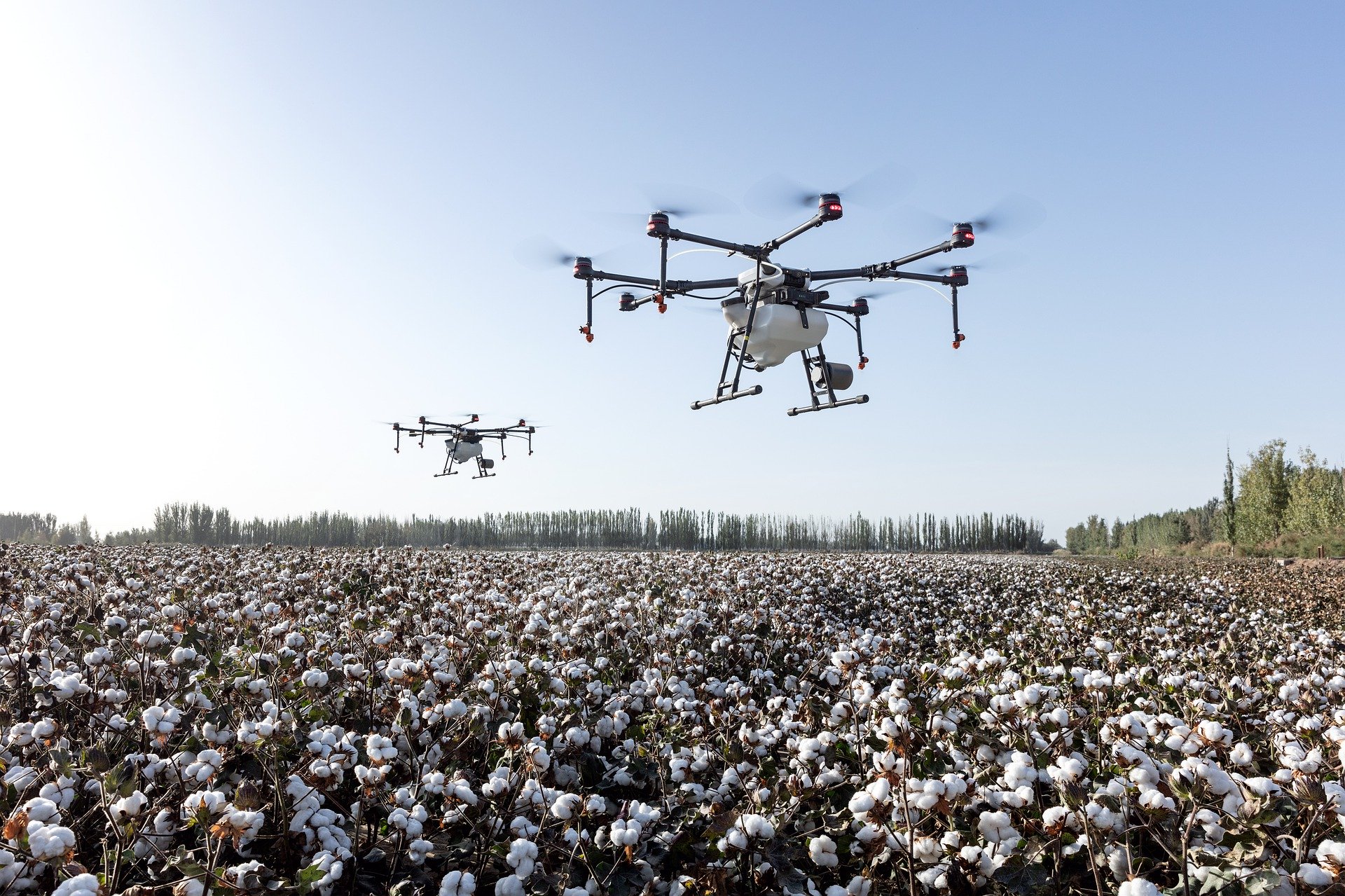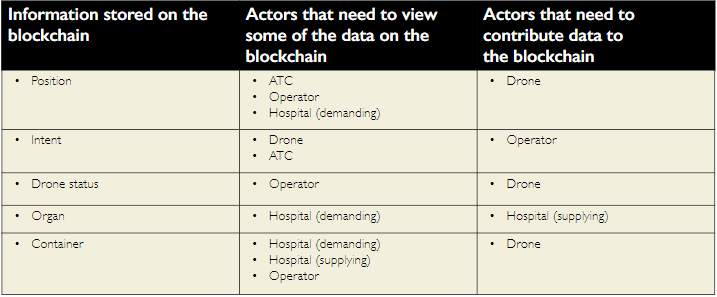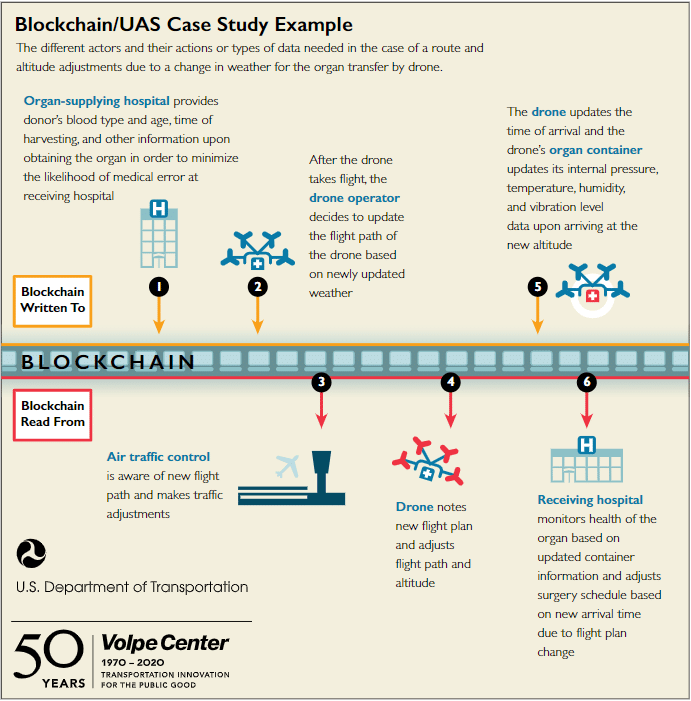Latest news about Bitcoin and all cryptocurrencies. Your daily crypto news habit.
According to The U.S. Department of Transportation (U.S. DOT), blockchain can be used to streamline drone deliveries of essential and important items, such as organs. The institution published an information-exchange document on 15th of April 2020, to communicate their findings and thoughts with the public and begin a discussion about blockchain and drone fleet management.
Drones in the context of the document are considered to be any Unmanned Aerial System, i.e. UAS. This includes UAS for military, commercial, and recreational usage and how blockchain technology can be used as a framework to provide stakeholders with security, identity management on one end. On the other side, blockchain is going to be used to manage conflicts in flight plans, authorization, and general air traffic management.
According to the U.S. DOT, blockchain technology is already mature enough to instantly introduce trust in a group or network of entities, as long as there are known and anonymous participants.
Regina Houston, Chief of the Aviation Safety Management Systems Division of the U.S. DOT Volpe National Transportation Systems Center says: “Blockchain is poised to transform the way we think about and analyze safety data. This is particularly exciting for unmanned aerial vehicles. Blockchain can be part of the solution to collecting and sharing reliable data about drones. When you combine machine learning with the data blockchain can provide on UAS registration, accountability, and tracking, an entire world becomes available for drone safety analysis, decision making, and even regulation.”
While it’s unclear how long the U.S. DOT have been reviewing ideas for blockchain adoption into air traffic systems, this type of sentiment can result in amazing blockchain implementations. In the report they mention Red Cat, because of their beta implementation of a blockchain-based black box for UAS. The black box implementation was portrayed as beneficial to industry regulators, insurance companies, and pilots.
NASA is mentioned for their proposal published in January last year about a blockchain-based framework for automatic dependent surveillance broadcast, which is a system that secures aircraft privacy, protects UAS from DoS attacks, and prevents them from spoofing their identity. Compared to traditional delivery routes, drones cannot be slowed down by traffic and generally have a straight line to their destination – Photo by DJI-Agras
Compared to traditional delivery routes, drones cannot be slowed down by traffic and generally have a straight line to their destination – Photo by DJI-Agras
How does the U.S. DOT imagine this drone blockchain?
For their case study they presented the case for Drone Delivery of Organs. Naturally, this is a vital, time sensitive process where minutes can result in organ failure and unnecessary death. The blockchain framework they proposed for this use case contains 5 data sets, with 5 participants on each case. The drone will be able to communicate the status of the organ through sensors in the box, giving hospitals accurate information about the status of the delivery.
Amit Ganjoo, Founder and CEO of ANRA Technologies said: “In case of a package delivery operation, a blockchain-based repository could log information about the operations such as time, location, resources, delivery date, etc., and make the data accessible to authenticated users, and any other stakeholders along a package’s route.”
The U.S. DOT provided this graphic in their document:
 Photo by Volpe National Transportation Systems Center
Photo by Volpe National Transportation Systems Center
While most of the participants in this case study share a positive outlook and general acceptance that blockchain must be included for this to work as intended, others came out with the concerns about potentially increasing the amount of drones making deliveries.
According to Hy Chantz, Associate Partner for Blockchain Solutions at IBM, massive drone fleets can create a significant security risks. He said: “Drones can fly over people and property and interfere with the operation of full-size aircraft. They could conceivably carry weapons or dangerous materials to critical locations. At a minimum, drones could take pictures, possibly committing privacy violations. There is also some concern that drones could aid in IT hacking by bringing sensors or disruptive electronics near a possible target.”
However, everybody else is looking at the positive facts from the past, especially towards the first organ drone delivery, which was completed in a record 5 minutes and the successful implementation of drones for bridge inspection.
All in all, organ drone deliveries work for shorter distances and this project can severely increase the speed at which these rare and critical elements of healthcare are delivered. Even in scenarios where the destination is a few hours away by plane, these types of drones can significantly increase successful organ deliveries. From the supplying hospital to the airport, onto a plane to the new destination, and directly on a drone to the receiving hospital.
The graph below describes how the U.S. DOT imagines the process of organ delivery through this system.
 Photo by Volpe National Transportation Systems Center
Photo by Volpe National Transportation Systems Center
Beyond organ drone delivery fleets
Another industry that will benefit from blockchain developments in the Organ Delivery industry is retail, with giants Walmart and Amazon already working on their own drone delivery fleets.
Walmart has been talking and working towards creating a blockchain-based drone fleet since 2017. Amazon Prime Air is another drone delivery service currently in development in the retail sector, however there is no mention of blockchain being used. Amazon however, has been participating in a research project with IBM that use blockchain systems to prevent drones from stealing packages.
In theory, if this project goes live, retail companies can join in on the blockchain to share data with air traffic controllers. Naturally, organ deliveries are far more important than anything else you can purchase, so we are curious to see in what capacity retail drone fleets will be implemented.
For now, we are not sure if there will be a single Air Traffic blockchain that drones will be required to communicate with, or there will be a separate system for each use case.
Photo credits: Karl Greif VideoDisclaimer
The views and opinions expressed in this article are solely those of the authors and do not reflect the views of Bitcoin Insider. Every investment and trading move involves risk - this is especially true for cryptocurrencies given their volatility. We strongly advise our readers to conduct their own research when making a decision.